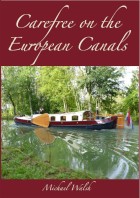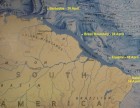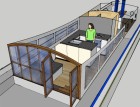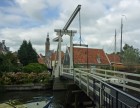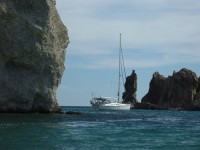Sequitur
Michael & Edi have headed out on a slow, thorough exploration of the globe.
| Vessel Name: | Sequitur and Zonder Zorg |
| Vessel Make/Model: | 2007 Hunter 49 and 1908 Wildschut Skûtsje |
| Hailing Port: | Vancouver, Canada |
| Crew: | Michael Walsh & Edi Gelin |
| About: | For our current location click, on Map & Tracking, then on the Google Earth logo. |
| Extra: | Follow us on Twitter: Follow @YachtSequitur |
| Social: |
13 January 2014
Another New Book Released
I am delighted to announce that my new book: Carefree on the European Canals is now in print and is available on Amazon.com, Amazon.ca [...]
26 April 2013
New Book Released
The proof copy of my new book arrived by courier today. I have approved it and it is now listed on Amazon for pre-order, with a publication date of 30 April. It is a rather large book at 680 pages in an 8.5 by 11 inch format with 315,000 words illustrated by over 2400 colour photos, charts and maps. [...]
24 April 2013
One Year Out of Brazil
One year ago today we sailed Sequitur out of Brazil after enduring more than six weeks in the least-friendly country that we had experienced during our three-year voyage. In the early evening of 24 April 2012 we crossed the line on the chart dividing Brazil from French Guyana and breathed a huge sigh [...]
27 October 2012 | Harlingen, Friesland
Planing a Metamorphosis
We have added a new post to the Zonder Zorg blog at: Planing a Metamorphosis.
29 September 2012 | Sneek, Netherlands
Onward to Friesland
We have arrived in Friesland and have added a new post to the skûtsje's blog at: Onward to Friesland
19 September 2012 | Hoorn, Netherlands
North From Aalsmeer
We have moved northward from Aalsmeer and I have added two new posts: Heading North From Aalsmeer and North From Amsterdam
13 September 2012 | Aalsmeer, Netherlands
Taking Possession
We are back in the Netherlands, and I have added some new posts to the ZonderZorg blog at: Taking Possession and Settling-In and Making Plans
20 August 2012 | Sequitur: St Augustine, USA - Michael & Edi: Vancouver, Canada - Nieuwe Zorg: Aalsmeer, Netherlands
Added a New Website
We have added a new website: Skûtsje ZonderZorg. Zonder zorg in Dutch means without worry. Our intention with the site is to provide a place to share some of the history, geography and culture of the skûtsje as we discover it. We will also use this place to document [...]
11 August 2012 | Sequitur: St Augustine, USA - Michael & Edi: Vancouver, Canada - Nieuwe Zorg: Aalsmeer, Netherlands
Still More Skûtsje History
We continued to attempt to track-down Douwe Albert Visser, who was the owner of Nieuwe Zorg in 1941 when she was re-registered. One of the problems we repeatedly encountered in our online searches was the effect of currently having Albert Visser and two Douwe Vissers as very competitive skûtsje racers, [...]
10 August 2012 | Sequitur: St Augustine, USA - Michael & Edi: Vancouver, Canada - Nieuwe Zorg: Aalsmeer, Netherlands
Some More Skûtsje History
While I was researching the history of Nieuwe Zorg, I finally found her first registration details obscured by an apparent typographical error in a transcribed online spreadsheet. She was listed as having been built in 1901 instead of 1908. I emailed the webmaster of the [...]
To Isla Partida
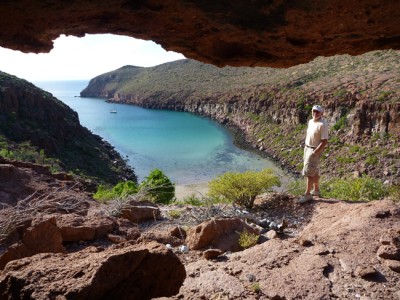
We weighed anchor shortly before 1100 on Monday the 28th and motored out of El Mezteno in seas as flat as plate glass, making water as we went to take advantage of the electricity from the engine's alternator. As we rounded Punta Mezteno, the point forming the north side of the anchorage, we had a view eastward into Caleta Partida and saw eight or ten boats at anchor there in the rather open roadstead, exposed to the winds funnelling through the gap separating Isla Espiritu Santo and Isla Partida; it was not our choice of anchorage.
Instead, we had decided to see if El Cardoncito, a narrow slit between the cliffs just outside Caleta Partida was empty. Unfortunately, as we looked northward a mile into El Cardoncito, there appeared to be a large schooner anchored in the middle of it, so we resigned ourselves to heading into the much larger Ensenada el Cardonal immediately to its north.
As we continued northward, it became increasingly obvious that the schooner was, in fact, at anchor on some diving and snorkelling rocks just outside the entrance to El Cardoncito, and the anchorage was empty. We slowly nosed our way into the canyon. The cliffs standing directly out of the water on both sides meant there was likely deep water right up to them, and we continued down the middle until the water began shoaling near the beach. At 1120 we came to 21 metres on the Rocna in 7 metres of water.

This is a delightful little spot, with porous red rock cliffs standing twenty to forty metres vertically along both sides before lying back to gentler slopes, which are dotted with succulents, bushes and cacti to the 150 metre high ridgelines. The porous rock looks like sponge candy, with frequent larger voids, many three metres and more in size which in our imaginations are fairytale cave dwellings. The cliffs are less than half-a-cable on each hand, and there is a small white sand beach at the head of the bay, less than a cable-and-a-half forward.
Although the sun had slanted in through the hatches into our cabin first thing in the morning, by the time we had gotten out of bed, it was overcast. As the morning progressed, the skies darkened, and a couple of hours after we had entered the anchorage, it began raining. This was the first rain Sequitur has seen since a two-day rainstorm that welcomed us to San Francisco two-and-a-half months ago, and she was quite salty. We waited for the boat to be well wetted, and then stripping-off our clothes and grabbing mop and cloths, we went out to help the rain wash the salt from the boat.

The rain continued for a couple of hours, and then stopped for a while, but the low dark clouds persisted, and it rained off and on until shortly before sunset. During one of the lulls in the rain a curious seagull landed on the dinghy, which was still hoisted in the davits, and stood there watching us and posing patiently for the camera.
The gull came back on Tuesday morning and sat waiting for us, so Edi got some leftover couscous with shrimp, and tossed bits into the water. The gull quickly scooted for the scraps of food as they were tossed, and when other gulls came close, it very aggressively defended its territory. This was its boat; time had been invested in wooing the boaters, effort had been put into posing for a photo shoot, no gull-come-lately was going to usurp its place.

We breakfasted in the cockpit, watching as the sun heated the rocks, converting Monday's rains into fluffy cumulus, which quickly dissipated as they rose. At about 1100 we took the dinghy for a slow two-hour circuit along the base of the cliffs lining both sides of the anchorage. Along the way, we paused to watch a twenty-four legged starfish clinging to the rocks, a brightly-coloured crab climbing up the rocks, and pelicans perched on the rocks.

We also examined close-up the wondrous rock formations; here lining this anchorage are some of the most fantastic rocks we have ever seen. We saw frothy pink icing flowing over marshmallow pillars, a jumble of pauper's swollen bare shins and feet sticking out below tattered hems, stacks of pale red sponge candy, fairytale cliff cities; our minds strained trying to find ways to describe the formations.

We pondered the cataclysmic events that would have caused the huge variety of structure among the clearly defined strata that is so evident throughout the anchorages here in Isla Espiritu Santo and Isla Partida. It is obvious that there was a long series of volcanic eruption of widely differing types. Adding to the complexity of the formations is the general tilt of the strata, here dipping ten or fifteen degrees to the west, and thereby making accessible the diversity of exposure along the east-west tending inlets of the islands.

We returned onboard from our circuit to have lunch. Then mid-afternoon we took the dinghy to the sandy beach at the head of the inlet and landed it at low tide. The beach here is nearly flat, so hauling the dinghy to the high water line was not practical. Instead, we landed near the rocks that form the southern margin of the beach, and hauled the dinghy a short distance across the sand before we took the painter around the natural bollard of a rock.

Water from the rain was still running across the sand from the arroyo, which at this time of year is usually dry. We ascended a broad gully filled with large broken rocks and when it became too choked with vegetation, we moved out onto the more open terrain of the spur to its left. We continued to encounter bands of sponge rock, and in one, we fancied we were visiting the local mail box to see if there was anything for us.

We continued up, exploring the varying rock formations and being watched by a variety of lizards. Some, 10 or 15 centimetres in length, were rather timid and quickly scooted off, while others, about 40 centimetres from snout to tail tip, were more curious and boldly watched us from a metre or two away.

Once we had reached the top of the line of cliffs, we circled back along the southern rim of the precipice to a spot overlooking Sequitur at anchor. This vantage point gave us a clear impression on how narrow the anchorage is and how well-protected it is from anything but a southwest wind. From our stance on the cliffs we paused to survey the incredible terrain through which we were wandering; this is truly an enchanted area.
By the time we had picked-out a route down through the lines of cliffs and walked along the rocks at the water's edge, back to the dinghy, the tide had come in sufficiently to float it. We pulled the dinghy over to a rock, and hopped-in. A few poles with the oars, and some weight shifting had us over the shallows and heading back out to Sequitur.

Back onboard, we hoisted the dinghy on the davits in preparation for the next morning's departure. When we came back up into the cockpit a while later to watch the sunset, our curious little seagull was once again on its perch on the dinghy. It posed for a photo session in the sunset, adding yet another special moment to our wondrous time in this enchanted place.

